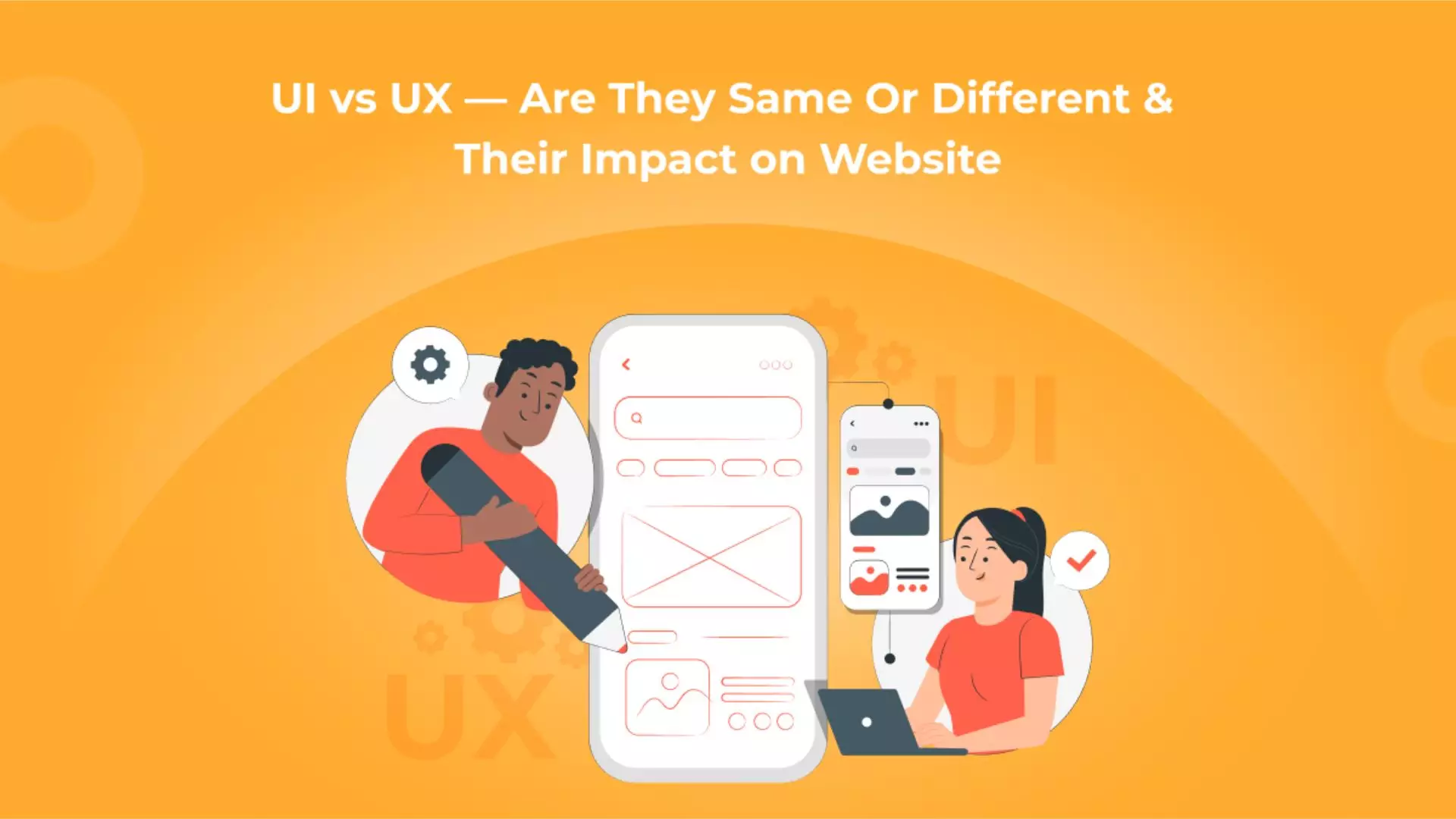Introduction
The richness of a website’s user experience (UX) in the modern digital era impacts its performance. The term “UX” consists of aspects such as usability, effectiveness, accessibility, and user experience, that enhance a user’s overall experience. Yet, the user interface (UI) and user experience (UX) are frequently confused, which obscures their respective functions and effects on website.
The visual aspects of a product, such as color choices, navigational features, and button styles, are the core of user interface design. On the other side, user experience (UX) focuses the way a user navigates a product. While UI is more visually oriented, UX is often more structural. In this article, We’ll talk about how UI and UX vary and how that impacts a website’s appearance and usability.
What does UI mean?
A website’s visual design and layout are called its user interface (UI). It contains aspects that enhance the visual quality of the website, such as font, color scheme, graphics, and other design elements. The main objective of UI is to design a visually engaging and aesthetically pleasing user interface that draws users in and encourages them to explore the website in more detail. A website’s user interface (UI) can improve the user experience and increase site engagement by making the site look authentic and professional.
Several user interfaces (UI) combine to create a product in an (ideally) seamless transition for a wholesome experience while using it. As its focus is evident from its name—interfaces—we may define the boundaries of UI in a much more definitive manner than UX. User experience is the overall impact of a series of these interfaces with all the additional, less noticeable aspects of a product’s functionality. Thus, UI focuses on the appearance of particular screens or interfaces along the user’s journey.
What does UX mean?
User experience (UX) includes the entire interaction that the user experiences while visiting a website. It has features including user experience, scalability, productivity, and ease of use. The user can use the website to its highest extent if the UX design is effective.
The task of the UX designer is to provide a user-centered design that is simple to understand and utilize. They have to be able to foresee the user’s behaviors, comprehend their preferences and requirements, and create a website that lives up to their expectations. User satisfaction, bounce rates, and website engagement can all be improved with creative UX design.
How do UI and UX work together?
A successful website requires the cooperation of both UI and UX, which are closely intertwined. Although the UX designer ensures the website is simple to use and accomplishes the user’s objectives, the UI designer provides an eye-catching design that grabs the viewer’s attention. A good UX design ensures that users stay & interact on the website, while a good UI design can draw users’ interest.
In other words, neither UI nor UX functions without the other. To ensure that users can interact with your product smoothly and engagingly, one must consider both factors while designing a user-centric solution.
Also Read: How to Migrate from Blogger to WordPress
How do UI and UX Impacts Website Design?
A good user experience and appealing website design can significantly impact the company’s performance. Moreover, UI and UX have the following impacts on website design:
User Attraction
Users may visit a website if it has an eye-catching design. The user may become interested in the website and wish to explore it more due to a well-designed user interface (UI). On the other hand, a poor UI might drive away users and cause a high bounce rate.
User Retention
A pleasant user experience helps to keep visitors on the page longer. Users’ ability to satisfy their purpose on a website can be made simple by a well-designed user experience (UX) that improves engagement and lower bounce rates. However, a poor user experience could frustrate visitors and increase bounce rates.
User Conversion
Users can become clients with the help of an effective UI and UX. Increased conversions might occur from a well-designed website that provides a positive user experience by gaining the user’s trust and credibility. On the contrary, an improperly designed website is not credible or trustworthy, which can minimize conversions.
Ease of access
Website accessibility is also affected by UI and UX design. A website can become more accessible with a well-designed user interface, understandable typography, and a pleasing color scheme. It becomes more accessible to a larger audience by having a strong UX design that acknowledges the user’s needs.
What is the role of research in the process of creating UI/UX designs?
The UI and UX design processes both certainly benefit from research. Both UI and UX designers must learn as much as they can about the needs and expectations of consumers for a product to be successful. User needs and desires, user experience, creative designs, and competitor approaches can all be gleaned from research. This provides more context to UI and UX designers, enabling them to decide what to do and whether they’re going on the right path.
Research of User Experience(UX) design
UX designers should ensure they are addressing actual, pertinent problems before entering into the design. There are various UX challenges which are faced by designers while building web application development . But how should that be accomplished?
UX research involves gathering insights to understand actual users’ requirements and concerns. This enables designers to look for widespread issues before focusing their efforts on making better solutions.
Research of User Interface(UI) design
UI research ensures that user needs and intentions are considered while designing the site’s interface, which is typically the first step in the process.
The UI design process begins after understanding the user experience. UI designers collaborate closely with Design professionals and product designers to study the outcomes of user research, understand the target audience and comprehend the purpose of the design project.
How to Build an Effective Website?
It’s important to consider both UI and UX design into account when developing an effective website. Here are some tips for designing a website that provides a positive user experience:
Also Read: How to create a website with WordPress
Specify the user base
Defining the user is essential before commencing website design. Such as who are they? What are their requirements and preferences? So, you can create a website that satisfies their goals and delivers an excellent user experience by understanding the user first.
Prioritize usability
An essential component of UX design is usability. It’s crucial to check that the website is simple to navigate and has an appealing layout. Thus, the website should make it easy for users to meet their goals.
Focus on accessibility
Another critical aspect of user experience design is accessibility. It’s important to develop websites that are user-friendly for everyone, including people who are visually impaired. The use of clear font, effective color contrast, and alternative text for photos are all excellent examples of this.
Considering visual design
Visual design contributes to the user experience, which is enhanced by accessibility and ease of use. A user interface (UI) that is well-designed can grab the user’s interest and attract them to keep researching the website. Hence, finding the balance between design and functionality is important.
Examine and refine
Checking and refining the website layout is necessary too. User testing can deliver insightful information about how users interact with the website and potential improvements. You can develop a website that delivers an excellent user experience by enhancing the design periodically.
Conclusion
Although UI and UX are often misunderstood, they serve different purposes in website design. While UX includes the entire user experience, UI concentrates on the visual appearance and layout of a website. With both an engaging UI and an intuitive UX, a successful website design must maintain a balance between the two.
It is inconceivable to underestimate the importance of UI and UX in website design. A well-designed website with a satisfying user experience can increase website engagement, and usability to keep users turning into customers. You can develop a website that provides an exceptional user experience to help your business succeed by emphasizing functionality, accessibility, creative style, testing, and refinement.
As the driving force behind WikiPluck, I am dedicated to curating and sharing insightful knowledge across a spectrum of subjects. From technology trends to Business advice, WikiPluck strives to be a go-to resource for those seeking to enhance their understanding and make informed decisions.
Join me on this journey of discovery and enlightenment as we pluck the gems of wisdom from the vast landscape of knowledge.

